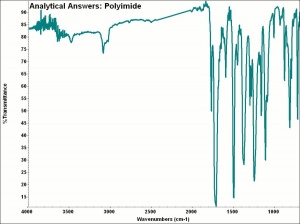Difference between revisions of "Polyimide"
Jump to navigation
Jump to search
(username removed) |
|||
| (2 intermediate revisions by 2 users not shown) | |||
| Line 1: | Line 1: | ||
== Description == | == Description == | ||
| − | A polymer formed from the condensation product of an aromatic dianhydride and an aromatic diisocyanate. Polyimides are similar to polyamides but much more heat resistant. They can be formulated as either thermoplastic or thermosetting resins and have been used for adhesives, binders, and fibers. Polyimide fibers (P- | + | A polymer formed from the condensation product of an aromatic dianhydride and an aromatic diisocyanate. Polyimides are similar to polyamides but much more heat resistant. They can be formulated as either thermoplastic or thermosetting resins and have been used for adhesives, binders, and fibers. Polyimide fibers (P-84®) were developed in Austria. They have good chemical resistance and are flame retardant. Polyimide fibers are used in nonwoven fabrics, emission filters, and some types of protective clothing, especially in Europe. |
| − | + | [[[SliderGallery rightalign|aaiP-IMIDE.jpg~FTIR]]] | |
== Synonyms and Related Terms == | == Synonyms and Related Terms == | ||
PI; poliimida (Esp.); polyimide (Fr.); poliimida (Port.) | PI; poliimida (Esp.); polyimide (Fr.); poliimida (Port.) | ||
| − | Examples: | + | Examples: Vespel® [DuPont]; P-84® [Inspec]; Meldin® [Saint-Gobain]; |
| − | + | == Risks == | |
| − | + | Nonflammable | |
| − | + | == Physical and Chemical Properties == | |
| − | + | * Melting Point = >315 | |
| − | + | * Cross section of fiber is multi-lobal and irregular | |
| − | |||
| − | |||
| − | |||
| − | |||
| − | |||
| − | |||
| − | |||
| − | == | + | ==Resources and Citations== |
| − | * | + | * Theodore J. Reinhart, 'Glossary of Terms', ''Engineered Plastics'', ASM International, 1988 |
| − | * | + | * Hoechst Celanese Corporation, ''Dictionary of Fiber & Textile Technology'' (older version called Man-made Fiber and Textile Dictionary, 1965), Hoechst Celanese Corporation, Charlotte NC, 1990 |
| − | * Art and Architecture Thesaurus Online, | + | * Art and Architecture Thesaurus Online, https://www.getty.edu/research/tools/vocabulary/aat/, J. Paul Getty Trust, Los Angeles, 2000 |
| − | * | + | * Textile World: www.textileworld.com/categories/9905/fibers.html |
[[Category:Materials database]] | [[Category:Materials database]] | ||
Latest revision as of 13:32, 22 October 2022
Description
A polymer formed from the condensation product of an aromatic dianhydride and an aromatic diisocyanate. Polyimides are similar to polyamides but much more heat resistant. They can be formulated as either thermoplastic or thermosetting resins and have been used for adhesives, binders, and fibers. Polyimide fibers (P-84®) were developed in Austria. They have good chemical resistance and are flame retardant. Polyimide fibers are used in nonwoven fabrics, emission filters, and some types of protective clothing, especially in Europe.
Synonyms and Related Terms
PI; poliimida (Esp.); polyimide (Fr.); poliimida (Port.)
Examples: Vespel® [DuPont]; P-84® [Inspec]; Meldin® [Saint-Gobain];
Risks
Nonflammable
Physical and Chemical Properties
- Melting Point = >315
- Cross section of fiber is multi-lobal and irregular
Resources and Citations
- Theodore J. Reinhart, 'Glossary of Terms', Engineered Plastics, ASM International, 1988
- Hoechst Celanese Corporation, Dictionary of Fiber & Textile Technology (older version called Man-made Fiber and Textile Dictionary, 1965), Hoechst Celanese Corporation, Charlotte NC, 1990
- Art and Architecture Thesaurus Online, https://www.getty.edu/research/tools/vocabulary/aat/, J. Paul Getty Trust, Los Angeles, 2000
- Textile World: www.textileworld.com/categories/9905/fibers.html
